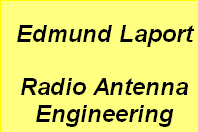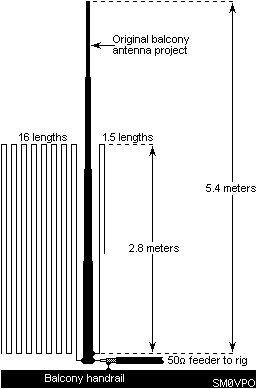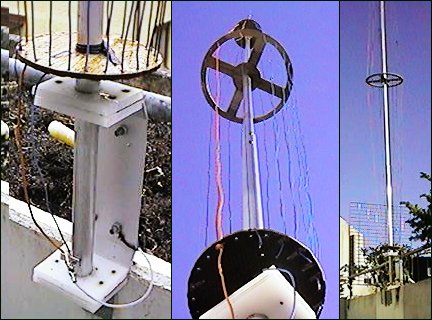

Antentop is FREE e-magazine devoted to Antennas and Amateur Radio an
Special page devoted to
Balcony Antenna Extension

Custom Search
|
ANTENTOP-
01- 2005, # 007 |
Balcony Antenna Extension |
|||
|
|
||||
|
bands without an ASCTU (ASTU
or ATU). I have not tested the coverage outside amateur bands,
I stopped when the VSWR became 3:1 or when the band edge was encountered.
So what is the big secret? I have mentioned before in these pages
that several 1/4-wave or 1/2-wave antennas can be placed in parallel
and fed with a single feeder. The resonant element will have an
effect; the others presenting a high impedance. I tried to add two 1/4-wave antennas to
cover the original 14MHz plus 29MHz, 18MHz and 3.6MHz. When I
tried it I was surprised that the antenna covered as much as 200KHz
of the 3.5MHz band and other HF bands were ALL useable. Reports
suggest that the effects on 14MHz have introduced a couple of
dB's loss, but that is far less than one "S-point".
Here is the drawing of the antenna showing the original 14MHz
pole (center) and the other two 1/4-wave antennas I have added. I have shown a graphic likeness of the routing
of the additional 43-meters of wire,
they are wound on three plywood disks. The top and bottom disks
are 100mm diameter and the center spacer disk is 300mm diameter,
each drilled with 18 holes. It would have been better to have
used nylon food reparation boards (from Ikea) but I didn't really
have all that much |
|
|||
|
confidence this antenna experiment would work so I began
with this make-shift arrangement. I must also point
out that putting your hand near this antenna will cause changes
to the readings, so you may need to make a few minor adjustments
in your own individual case. Here are photographs of the finished and
working prototype antenna. The
left insert shows the antenna mounted on the old balcony support
bracket with the coil removed. The center insert shows a view
from the bottom of the antenna. The orange wire is the 420cm 18MHz element.
The right insert shows most of the complete antenna from a little
distance. Notice how I have cut out material from the center spacer
to reduce wind resistance and to help make it look a little less
obtrusive for neighbors. The top spacer is identical to |
|
|||
|
the bottom spacer. All three of the elements are
connected in parallel at the feed point where I connected my 50-ohm
feeder. The old coil is now obsolete and has been removed. Please
note that this antenna idea is also governed by "Harry's
Law" of coils: You
cannot wind coils like me and I cannot wind coils like you. Coil-winding data is a constant
that varies from person-to-person. This
means that it may NEED some adjustment in your own environment,
depending upon proximity of other artifacts, humidity, groundplane
efficiency and even the color of the flag you have fitted to the
top of the original 14MHz pole. Begin
antenna assembly by making and fitting the top, middle and bottom
spacers. To trim the spacers, |
temporarily add a 3-meter length of wire, making a small
tight loop at the top to remove the surplus. Check the VSWR at
29MHz and adjust the top-spacer position, re-coiling the surplus
wire, until the antenna is resonant with VSWR better than 1.5:1. Fix the spacer
positions using hose-clamps or whatever other bright ideas you
may have. Now remove the 3-meter wire and sew the 40-meters of
wire through the holes. Check the VSWR at 3.6MHz, or whatever
part of the 80-meter band you want. Remove wire to achieve resonance.
Fit the 1.5-loop, 4.2-meter length of wire for the 18MHz element.
This loop only comes 1/2-way
down the cage, so add some nylon line and secure it to the bottom
spacer. Do not tie anything to the center spacer. The wire I used
was 7-ampere multi-strand household mains-wiring cable. Have fun with this project. Regards from Harry - SM0VPO -73!- |
|||
|
Page 45 |
||||
 |
 |
 |
 |
Just for Fun:

Powered byIP2Location.com
Thanks for your time!
Last Updated:
February 22, 2020 20:33






